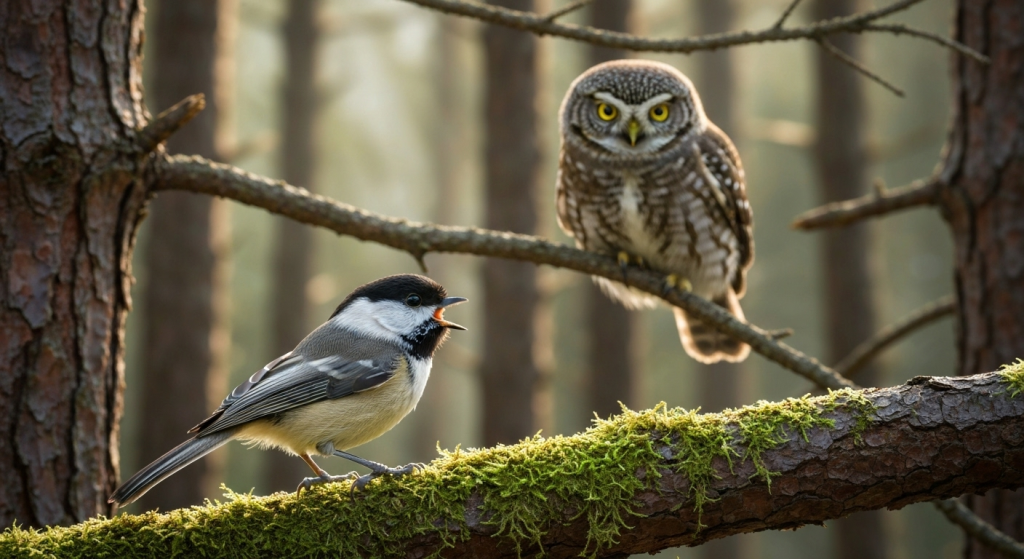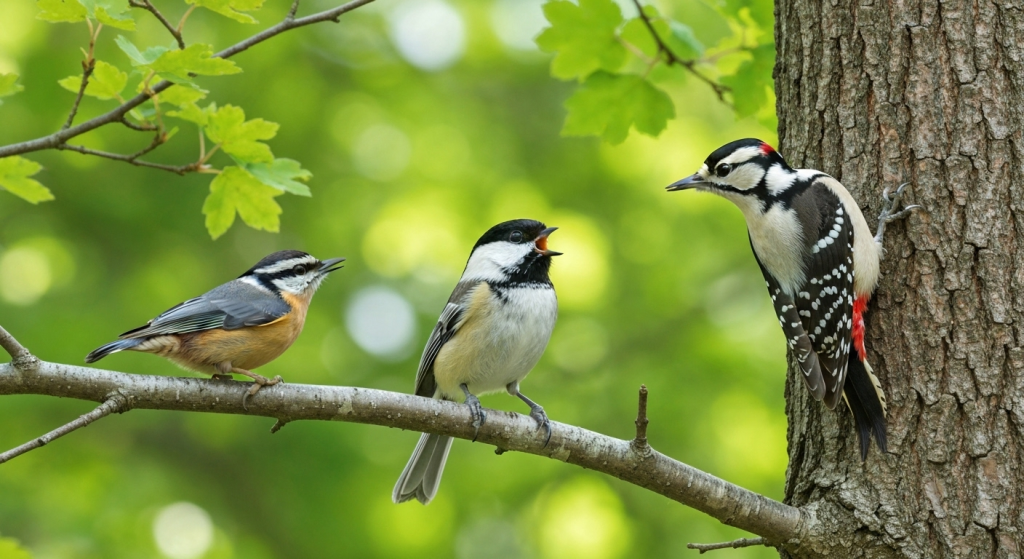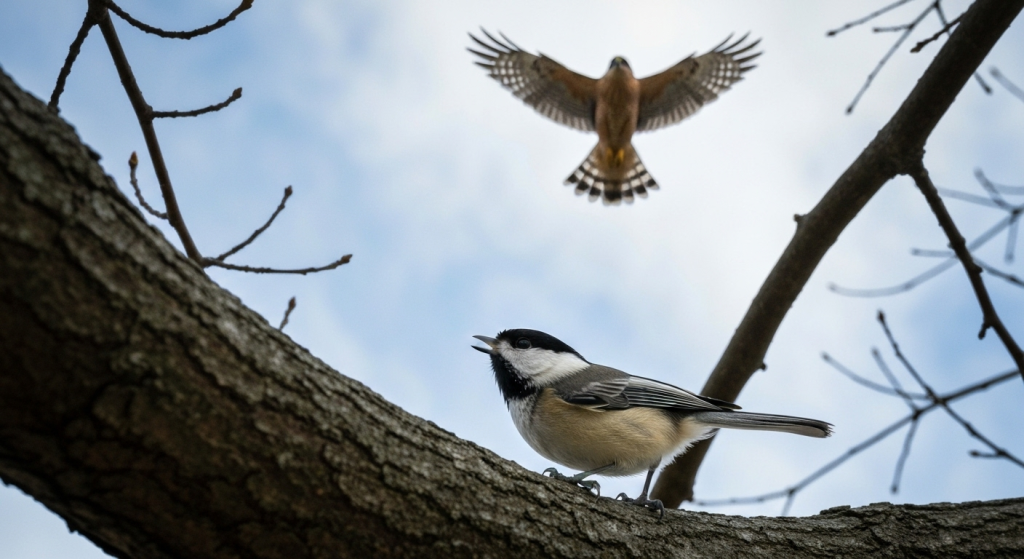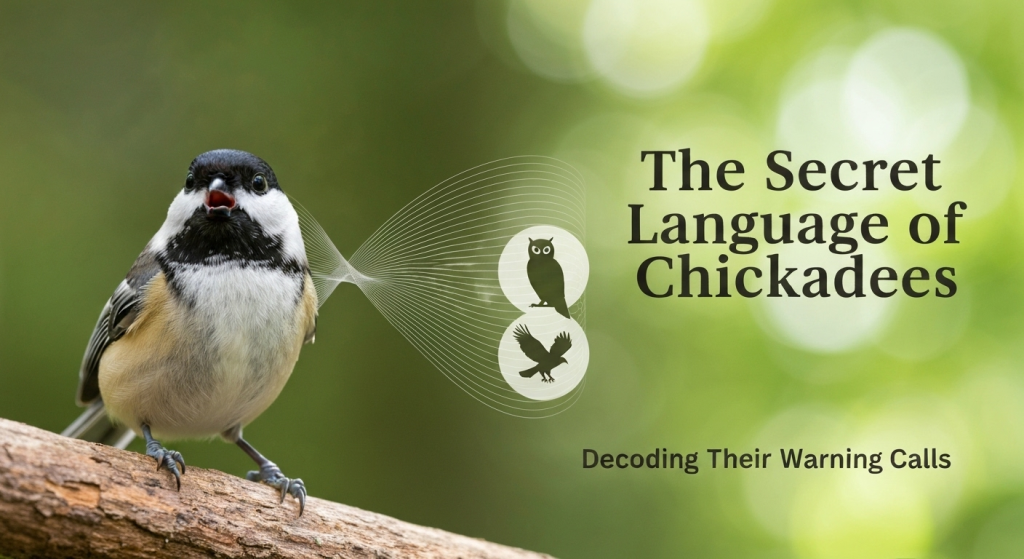If you’ve ever spent time in a park or a backyard in North America, you’ve almost certainly heard it. That cheerful, buzzy little call: “chick-a-dee-dee-dee.” It’s one of the most familiar sounds in the forest, easy to recognize and often overlooked. But what if I told you that simple sound is not just a sound? What if it’s a sophisticated language, a complex alert system that conveys detailed information about threats, danger, and the world around them? The common chickadee, it turns out, is a master communicator, and its calls are a masterclass in survival.
My name is Mahnoor Farooq, and for the past five years, I’ve been fascinated by how birds communicate. My journey hasn’t been in a formal lab but in the field—local woodlands, parks, and even my own backyard—armed with binoculars, a notebook, and a deep sense of curiosity. I spend my time observing these creatures, trying to connect the dots between the scientific research and what I see with my own eyes. My goal is to translate the dense, academic findings into something clear and exciting for anyone who has ever wondered what the birds are actually saying.
Let’s break down the hidden genius behind one of nature’s most intricate alarm systems. It’s a language that not only protects the chickadee flock but also serves as a public broadcast system for the entire forest community.
The Basics of the “Chick-a-dee” Call
Before we dive into the details, it’s important to understand that the “chick-a-dee” call is not a single, monolithic sound. It’s a modular system made of different parts, each with its own purpose. Think of it like building a sentence with different words. The call generally has two main components: the introductory notes, which can sound like “chick-a,” and the final notes, which are the famous “dee-dee-dee.”
This call serves a dual purpose. In a calm, relaxed context, it’s a contact call. It helps the members of a foraging flock keep track of each other as they move through the trees. It’s a way of saying, “I’m over here, where are you?” But when a threat is detected, this same call transforms into one of the most detailed alarm signals in the animal kingdom. The key to unlocking its meaning lies in the number, tempo, and acoustic structure of those final “dee” notes.
How a Simple Call Signals Complex Threats

The true genius of the chickadee’s language is its ability to convey not just the presence of danger, but the type and urgency of that danger. This was explored in groundbreaking research from scientists like Christopher Templeton at the University of Montana, who used controlled experiments to crack the code. They discovered that chickadees essentially perform a risk assessment and broadcast the results to everyone within earshot.
The “Dee” Count: A Measure of Danger
The most critical piece of information is encoded in the number of “dee” notes at the end of the call. Here’s the rule: the more “dee” notes, the greater the perceived threat. A chickadee isn’t just shouting “Danger!” It’s specifying how much danger.
From my own observations, this plays out exactly as the research suggests. I once watched a flock of chickadees foraging peacefully when a large, slow-moving Red-tailed Hawk soared high overhead. The first chickadee to spot it let out a calm “chick-a-dee-dee.” Just two “dees.” The flock took note, became more vigilant, but continued foraging. The hawk was big, but it was distant and not an immediate threat.
Contrast that with another time I saw a Northern Pygmy-Owl, a tiny and incredibly agile predator of small birds, perched silently in a dense thicket. The alarm call was electric and urgent: “chick-a-dee-dee-dee-dee-dee-dee-dee-dee!” I counted at least eight “dees,” fired off in rapid succession. The reaction was instant. The entire flock erupted into a frantic, agitated mob.
Here’s a simple breakdown of how this threat level system works:
| Threat Level | Predator Example | Typical Number of “Dee” Notes | Flock Response |
| Low | A large, perched hawk or a cat walking on the ground. | 2–4 | Increased alertness, birds may freeze temporarily. |
| Medium | A smaller hawk or a predator that is closer. | 5–7 | Agitation, flock members gather to assess the threat. |
| High / Urgent | A small, agile owl or a hawk actively hunting. | 8+ | Intense agitation, triggers mobbing behavior to harass the predator. |
It’s Not Just How Many, But How Fast: The Role of Acoustics
While the number of “dees” is the headline, there’s more information packed into the call. The acoustic qualities—like the tempo and pitch—add another layer of meaning. A call about a high-threat predator won’t just have more “dees”; those “dees” will be delivered faster and with a harsher, more energetic tone.
Think of it this way:
- A slow, evenly spaced “chick-a-dee…dee…dee” is like someone saying, “Okay everyone, just a heads-up, there’s a potential issue over there.”
- A rapid-fire, intense “chick-a-DEE-DEE-DEE-DEE-DEE!” is the equivalent of screaming, “Immediate danger, right here, right now!”
This combination of note count and delivery speed creates a remarkably descriptive signal. It allows the flock to make a split-second decision: is this a threat we need to watch, or is this a threat we need to actively fight?
A Public Broadcast System for the Forest

One of the most incredible things about the chickadee’s alarm system is that it’s not private. Chickadees are known as “community sentinels” because dozens of other species have learned to decode their calls. They are, in effect, providing a public safety service for their entire ecosystem.
Who’s Listening? Eavesdropping on Chickadee Alarms
When a chickadee flock sounds an alarm, they are rarely the only ones who react. A whole host of other birds and even small mammals tune in to this “chickadee network.” This is a phenomenon known as interspecies eavesdropping.
In my years of bird watching, I’ve learned that if I want to find other birds, my best bet is to first find the local chickadee flock. Where they are, others will be too, partly because they feel safer. I’ve seen Red-breasted Nuthatches, Downy Woodpeckers, Tufted Titmice, and various warblers all respond instantly to a chickadee’s alarm. The nuthatches, in particular, seem to be tightly integrated, often joining in mobbing a predator with just as much vigor as the chickadees themselves.
Why the Chickadee Call is So Effective for Others
Why do so many different animals trust the chickadee? There are a few key reasons. First, chickadees are bold and curious. They are often the first to investigate a potential threat and sound the alarm. Second, their calls are loud, distinct, and carry well through dense foliage.
But most importantly, the call is designed to recruit help. The “chick-a-dee” mobbing call is acoustically easy to locate. This is intentional. The bird is saying, “The danger is right here! Come help me drive it away!” This behavior, called “mobbing,” involves a group of smaller birds harassing a larger predator until it gets annoyed and leaves the area.
This shared security system offers several advantages for the entire forest community:
- Increased Vigilance: With chickadees on patrol, other birds can focus more on foraging without having to constantly scan for danger themselves.
- Safety in Numbers: Mobbing is far more effective and less risky when multiple species join in. A lone owl can handle a few angry chickadees, but it’s much harder to ignore a swarm of chickadees, nuthatches, and woodpeckers.
- Energy Conservation: By relying on a dedicated sentinel species, other animals conserve the energy they would have spent on surveillance.
Beyond the Alarm: Other Chickadee Vocalizations

To fully appreciate the complexity of their language, we have to look beyond the famous “chick-a-dee” call. Chickadees have a diverse vocal repertoire, and each sound is tailored for a specific situation.
The High-Pitched “Seet” Call
If the “chick-a-dee” call is for a perched, stationary predator, the “seet” call is for a moving, aerial one. This is the “duck and cover” alarm. It’s a very thin, high-frequency sound that is incredibly difficult for predators (and humans) to pinpoint. When a chickadee lets out a “seet” call, it’s signaling an immediate threat from above, like a Cooper’s Hawk in mid-flight.
The acoustic design is brilliant. The caller can warn its flockmates without revealing its own location to the predator. The response is instantaneous: birds dive for the nearest cover and freeze, becoming silent and still until the danger has passed.
Contact Calls and Songs
Besides alarms, chickadees have other sounds for daily life. They use a variety of soft, subtle contact calls to stay in touch with their flock while foraging. These are quiet murmurs that don’t attract unwanted attention.
In the spring, you’ll hear their iconic song: a clear, two- or three-note whistle that sounds like “fee-bee” or “cheese-bur-ger.” This song is used by males to establish territory and attract a mate. It’s a message of ownership and availability, not of danger.
Here is a comparison of their main vocalizations:
| Vocalization | Primary Purpose | Acoustic Properties | Elicited Response |
| “Chick-a-dee” Call | Alarm for stationary/perched predators; flock communication. | Loud, buzzy, easy to locate. | Alertness, investigation, or mobbing. |
| “Seet” Call | Alarm for aerial predators in flight. | Thin, high-pitched, hard to locate. | Immediate dash for cover; freezing in place. |
| “Fee-bee” Song | Territorial defense and mate attraction. | Clear, melodic whistle. | Response from rival males or interested females. |
Seasonal Shifts in Chickadee Communication
A chickadee’s language isn’t static; it changes with the seasons. During the fall and winter, chickadees form large, mixed-species foraging flocks. This is when the “chickadee network” is most active. Contact calls and mobbing alarms are frequent as the group works together to find scarce food and defend against predators. Social communication is paramount for the flock’s survival through the harsh winter months.
Come spring, these large flocks disband as birds pair up for the breeding season. The soundscape shifts dramatically. The constant chatter of the flock is replaced by the loud, persistent “fee-bee” songs of males defending their nesting territories. While alarm calls are still used, the dominant message in the air is about territory and romance.
How Can You Learn to Decode Chickadee Calls?
The best part about this complex language is that anyone can learn to understand it. You don’t need a biology degree, just a little patience and active listening. It has completely changed my experience of being outdoors. I no longer just hear noise; I hear a conversation.
Start by Listening Actively
The next time you’re outside, take a moment to just listen. Don’t try to identify every sound. Instead, focus on the chickadees. Hear their basic “chick-a-dee-dee” call when things are calm. Get a feel for the normal rhythm of their communication.
Pay Attention to the “Dee” Count and Rhythm
When you hear a call, try counting the “dees.” Notice the tempo. Is it slow and relaxed, or is it fast and frantic? Once you hear an agitated call with many “dees,” stop and scan the area. Look for a perched hawk, an owl, or even a neighborhood cat. You will be amazed at how often you can spot the source of the commotion.
Observe the Response of Other Birds
The surrounding birds are your best confirmation. Did a sharp “seet” call cause every bird in the vicinity to vanish into the bushes? Did a loud series of “dees” cause nuthatches and titmice to fly towards the sound to investigate? The reactions of the wider community will tell you almost everything you need to know about the nature of the alarm.
Frequently Asked Questions (FAQs)
Do all chickadee species have this complex alarm call?
Yes, this complex system has been documented in multiple chickadee species, including the Black-capped, Carolina, and Mountain chickadees. While there may be slight “dialect” differences, the basic rule of more “dees” for greater threats holds true across the genus.
Can chickadees describe the size of a predator?
Research strongly suggests they can. In experiments, chickadees consistently used more “dee” notes in response to smaller, more agile predators (like pygmy-owls) than to larger, less maneuverable ones (like great-horned owls), indicating they are communicating the specific level of danger posed by the predator’s size and agility.
How do young chickadees learn these calls?
This appears to be a combination of instinct and learning. While young birds have an innate ability to make the calls, they refine their understanding of which predators are dangerous by observing the reactions of adult birds in the flock.
Why do other birds trust the chickadee’s alarm?
Chickadees are reliable and have a low rate of false alarms. Because they are active, non-migratory residents, they have an intimate knowledge of their territory and the resident predators. Over evolutionary time, other species have learned that when a chickadee sounds an alarm, it’s a signal worth paying attention to.
Conclusion:
The familiar “chick-a-dee-dee-dee” is far more than just a cheerful chirp. It’s a window into a world of incredible complexity, a language of survival that protects not just one bird, but an entire community. It carries detailed information about the world, broadcast for all to hear. The chickadee reminds us that even the most common creatures can possess extraordinary intelligence and that there are incredible stories unfolding all around us, if we only take the time to stop and listen.


